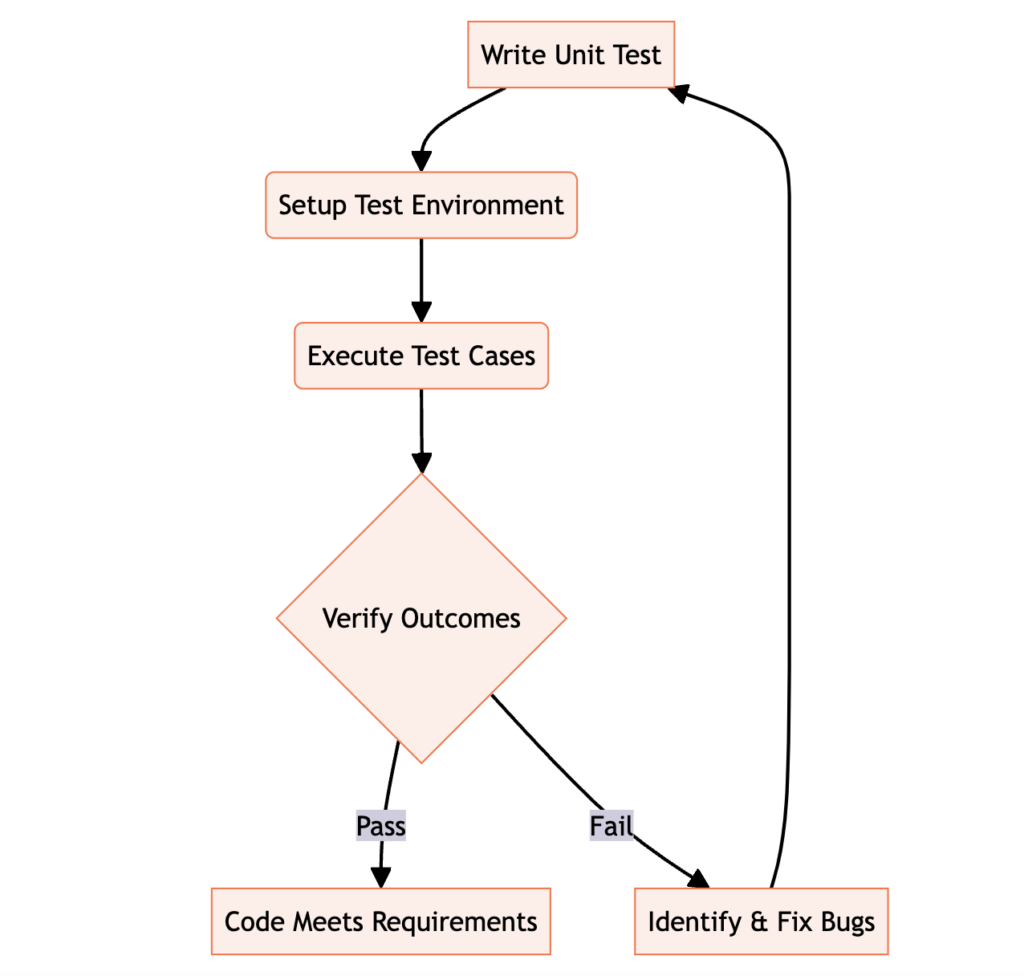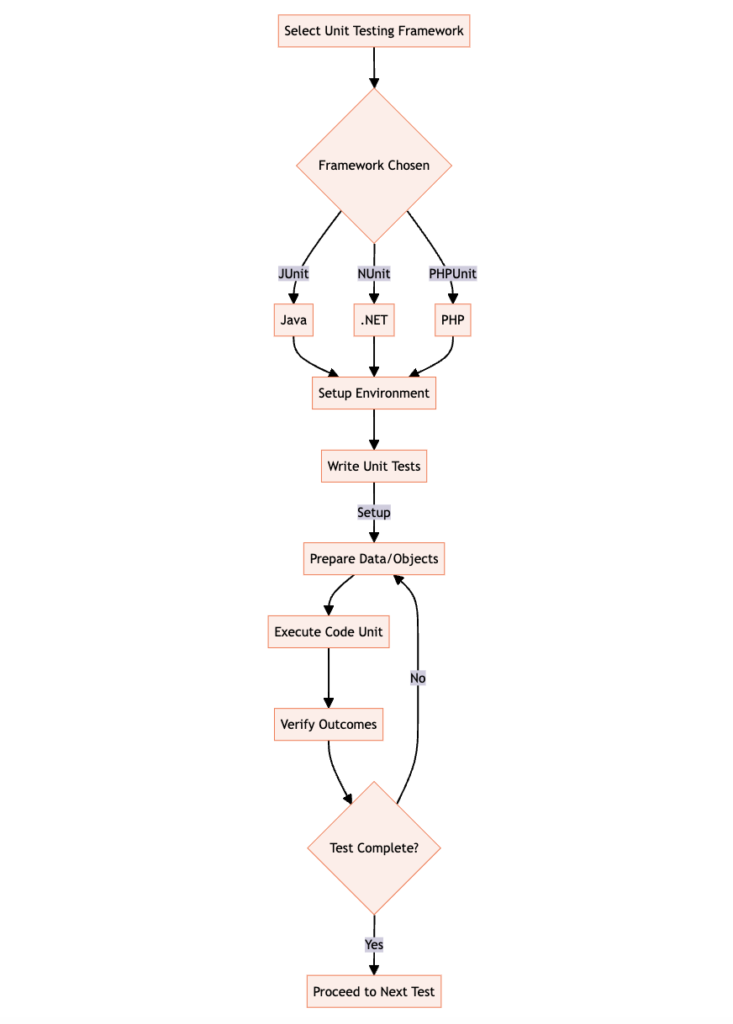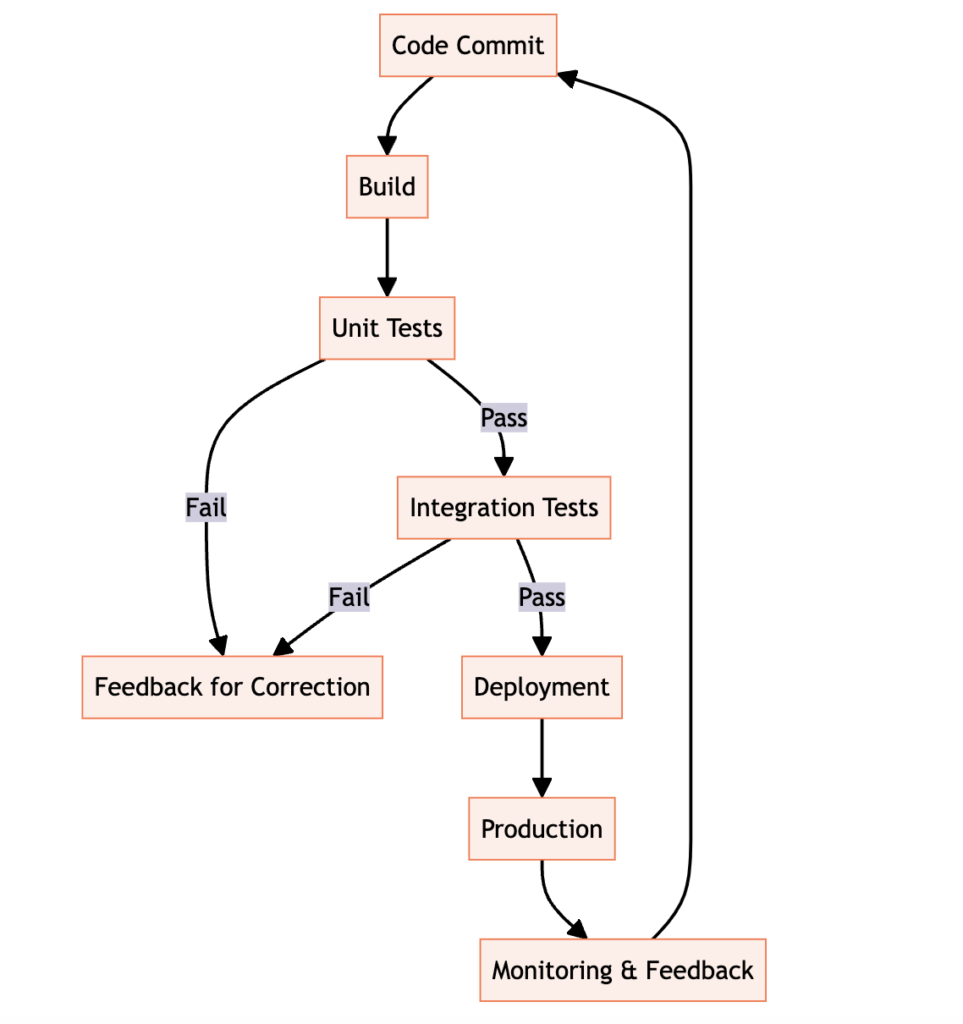Introduction to Unit Testing
Unit testing is a fundamental practice in software development, focusing on testing individual units of code to verify their correct functionality in isolation. This guide aims to explore the importance of unit testing, the setup of a unit testing environment, and the adoption of best practices for effective unit testing.

The Significance of Unit Testing
Unit testing is instrumental in the software development process, aiding in the early identification and rectification of bugs. By isolating and testing each code unit, developers can confirm that the code performs as intended and adheres to the specified requirements. This approach not only elevates the software’s overall quality but also conserves time and effort over the long haul.
Establishing a Unit Testing Environment
Selecting a Unit Testing Framework
To initiate a unit testing environment, the selection of an appropriate framework is essential. The table below outlines several popular unit testing frameworks along with their corresponding programming languages:
| Framework | Language |
|---|---|
| JUnit | Java |
| NUnit | .NET |
| PHPUnit | PHP |
These frameworks offer a comprehensive set of tools and libraries that streamline the writing and execution of unit tests.

Crafting Unit Tests
Developers embark on writing unit tests by focusing on three core stages: setup, execution, and verification.
- Setup: Preparation of necessary data and objects.
- Execution: Invocation of the code unit under test and observation of outcomes.
- Verification: Comparison of actual and expected results to determine test outcomes.
Test Coverage Considerations
It’s crucial to cover a range of scenarios and edge cases to achieve extensive test coverage. Tests should encompass both typical and exceptional cases to detect any underlying issues. Furthermore, maintaining test independence ensures that the outcome of one test does not influence another.
Best Practices for Unit Testing
- Test-Driven Development (TDD): Writing tests prior to the actual code, guiding the development process and ensuring code testability.
- Focused Testing: Creating small, focused tests that target specific functionalities facilitates easier debugging and issue resolution.
Unit Testing’s Role in Software Development
Unit testing is indispensable in software development, ensuring code quality, preventing bugs, and validating software reliability. By adhering to best practices and properly setting up the unit testing environment, developers can significantly enhance their testing efficiency and effectiveness.
Advanced Unit Testing Setup
Version Control and Continuous Integration
Configuring your development environment with version control (e.g., Git or Subversion) and a continuous integration (CI) system (e.g., Jenkins or Travis CI) is paramount. This setup facilitates automated unit test execution and offers immediate feedback on the codebase status.

Coding Standards and Test Data
Implementing coding standards and generating realistic test data are essential steps. Tools like Faker or Test Data Builder can assist in creating test data, ensuring tests are consistent and maintainable.
Organizing Tests
A clear and organized directory structure for unit tests simplifies maintenance and enhances test suite navigability. Grouping tests by module or functionality aids in locating and executing specific tests efficiently.
How Test-Driven Development (TDD) Enhances Unit Testing
Test-Driven Development (TDD) is an approach to software development that emphasizes writing tests before writing the actual code. By following the TDD process, you can ensure that your code is thoroughly tested and that it meets the desired requirements.
In this section, we will introduce the concept of TDD and explain how it influences unit testing and software design. We will discuss the benefits of using TDD, such as improved code quality, faster development cycles, and better collaboration within development teams.
One of the key aspects of TDD is that it forces developers to think about the desired behavior of the code before they start implementing it. This helps in clarifying the requirements and understanding the expected outcomes. By writing tests first, developers have a clear understanding of what the code should do, which leads to more focused and efficient development.
Moreover, TDD promotes a modular and loosely coupled code structure. Since tests are written before the code, developers are encouraged to break down the problem into smaller, more manageable units. This leads to the creation of small, focused functions or classes that are easier to test and maintain. As a result, the codebase becomes more modular and less prone to bugs and errors.
Another benefit of TDD is that it provides a safety net for refactoring. Refactoring is the process of improving the code without changing its behavior. With TDD, developers can confidently refactor their code knowing that if they accidentally introduce a bug, the tests will catch it. This allows for continuous improvement of the codebase without the fear of breaking existing functionality.
TDD also promotes collaboration within development teams. Since tests are written before the code, they serve as a form of documentation that clearly states the expected behavior of the code. This makes it easier for other developers to understand and work with the codebase. Additionally, TDD encourages developers to discuss and agree upon the desired behavior before writing any code, fostering better communication and collaboration among team members.
Now you know that Test-Driven Development enhances unit testing by providing a structured approach to software development. It helps in improving code quality, speeding up development cycles, and promoting collaboration within development teams. By writing tests first, developers gain a clear understanding of the desired behavior, leading to more focused and efficient development. The modular code structure and safety net for refactoring provided by TDD further enhance the reliability and maintainability of the codebase. Overall, TDD is a valuable practice that can greatly enhance the effectiveness of unit testing and software development as a whole.
Best Practices for Effective Unit Testing in Software Development
To ensure that your unit tests are effective and maintainable, it is important to follow best practices. In this section, we will explore some strategies for writing high-quality unit tests and offer tips for organizing and naming your test cases.
We will also discuss advanced unit testing techniques, such as parameterized tests for broader coverage and techniques for dealing with legacy code and hard-to-test code. These techniques can help you overcome common challenges in unit testing and ensure that your tests are comprehensive and reliable.
One important aspect of writing effective unit tests is to ensure that they are focused and independent.
Each unit test should target a specific functionality or behavior of the code being tested.
By isolating the test cases, you can easily identify and fix any issues that arise, without impacting other parts of the codebase.
Another best practice is to use meaningful and descriptive names for your test cases. This makes it easier to understand the purpose of each test and helps in troubleshooting and debugging. A well-named test case should clearly indicate the expected behavior and any specific inputs or conditions being tested.
That said, it is important to regularly review and refactor your unit tests. As your codebase evolves, so should your tests. By periodically reviewing your tests, you can identify any redundant or unnecessary test cases and remove them. Refactoring your tests also helps in maintaining a clean and organized test suite, making it easier to add new tests in the future.
When dealing with legacy code or hard-to-test code, it is often helpful to use techniques such as test doubles and mocking frameworks. Test doubles, such as stubs and mocks, allow you to simulate the behavior of external dependencies or complex components, making it easier to test the code in isolation. Mocking frameworks provide a convenient way to create and configure these test doubles, reducing the effort required to set up and maintain the tests.
Would you like to get engaged with professional Specialists?
We are a software development team with extensive development experience in the Hybrid and Crossplatform Applications development space. Let’s discuss your needs and requirements to find your best fit.
Parameterized tests are another powerful technique that can help improve the coverage of your unit tests. Instead of writing separate test cases for each combination of inputs or conditions, you can use parameterized tests to define a set of inputs and expected outputs. This allows you to test a wider range of scenarios with fewer test cases, making your tests more efficient and maintainable.
In conclusion, following best practices for unit testing is crucial for ensuring the quality and reliability of your software. By focusing on isolation, naming, review, and refactoring, you can create a robust and effective test suite. Additionally, advanced techniques such as test doubles, mocking frameworks, and parameterized tests can help you overcome specific challenges and improve the coverage of your tests. By incorporating these practices into your development process, you can build software that is more reliable, maintainable, and bug-free.
Integrating unit tests with a Continuous Integration (CI) workflow is crucial for maintaining the quality and stability of your software project. By automating the process of building, testing, and deploying your code, you can catch any potential issues early on and ensure that your software is always in a releasable state.
Popular CI Tools
One popular CI tool that you can use to integrate your unit tests is Jenkins. Jenkins is an open-source automation server that allows you to set up pipelines to build, test, and deploy your software. With Jenkins, you can configure your pipeline to trigger your unit tests automatically whenever changes are made to your codebase. This ensures that any new code is thoroughly tested before it is merged into the main branch.
Another CI platform that you can consider is Travis CI. Travis CI is a cloud-based CI service that is widely used for testing and deploying open-source projects. With Travis CI, you can easily configure your project to run your unit tests on every commit or pull request. The results of the tests are displayed in the build logs, allowing you to quickly identify any failures or regressions.
If you prefer a hosted CI solution, CircleCI is worth exploring. CircleCI offers a cloud-based platform that allows you to automate your build, test, and deployment processes. With CircleCI, you can easily set up your unit tests to run in parallel across multiple containers, ensuring fast and efficient test execution. Additionally, CircleCI provides detailed test reports and coverage metrics, giving you valuable insights into the health of your codebase.
Regardless of the CI tool or platform you choose, it is important to configure your pipeline to run your unit tests automatically and report the results. This way, you can easily track the test coverage and identify any areas of your code that may need additional testing. By integrating unit tests into your CI workflow, you can ensure that your software is always thoroughly tested and ready for deployment.
Unit Testing in Multi-Layered Architectures
Unit testing becomes more challenging in complex software architectures that involve multiple layers, such as UI, business logic, and data access layers. In this section, we will discuss strategies for unit testing in multi-layered architectures and explore techniques for isolating dependencies and mocking external components.

We will also address common challenges in unit testing, such as dealing with asynchronous code, handling exceptions, and testing code that interacts with databases or external services. By understanding these challenges and applying the right techniques, you can ensure that your unit tests are comprehensive and reliable.
One important strategy for unit testing in multi-layered architectures is to focus on testing each layer in isolation. This means that when testing the UI layer, you should mock the business logic and data access layers, and similarly, when testing the business logic layer, you should mock the UI and data access layers. By isolating each layer, you can ensure that any failures or issues are specific to that layer and not caused by interactions with other layers.
Dedicated Full Stack Developers
Hiring Full Stack developers gives businesses access to pros proficient in various technologies and frameworks. Their versatility streamlines collaboration, leading to faster development and enhanced efficiency.
Another technique for unit testing in multi-layered architectures is the use of dependency injection. Dependency injection allows you to inject mock dependencies into your code during testing, which helps in isolating the code being tested from its dependencies. This way, you can control the behavior of the dependencies and ensure that your tests are focused on the specific functionality being tested.
When dealing with asynchronous code, such as callbacks or promises, it is important to use appropriate techniques to handle them in your unit tests. For example, you can use tools like Sinon.js to stub or mock asynchronous functions and control their behavior during testing.

This allows you to simulate different scenarios and ensure that your code handles asynchronous operations correctly.
Testing code that interacts with databases or external services can be challenging as well. In such cases, it is recommended to use mocking frameworks or libraries that allow you to create mock objects or stubs for the external dependencies. These mock objects can simulate the behavior of the actual dependencies and provide controlled responses during testing. This way, you can test your code without relying on the availability or consistency of the external dependencies.
You need to be aware that unit testing in multi-layered architectures requires careful planning and the use of appropriate techniques. By isolating each layer, using dependency injection, handling asynchronous code, and mocking external dependencies, you can ensure that your unit tests are effective in validating the functionality of your software.
Overcoming Common Challenges in Unit Testing
Yes it’s true: Unit testing is not without its challenges, and developers often encounter common pitfalls that can hinder the effectiveness of their tests. In this section, we will address some of these challenges and provide solutions for overcoming them.
Another challenge that developers often face is writing tests for code that is tightly coupled or poorly designed.
One of the most common challenges in unit testing is dealing with external dependencies. When writing unit tests, it is important to isolate the code under test from any external dependencies, such as databases or web services. This can be achieved by using techniques like mocking or stubbing, where you create fake objects or functions that mimic the behavior of the actual dependencies. By doing so, you can control the behavior of the dependencies and ensure that your tests are not affected by any changes or issues in the external systems.
Unit tests are most effective when they are written for code that is loosely coupled and follows good design principles, such as the Single Responsibility Principle or Dependency Inversion Principle. However, in reality, we often encounter code that is tightly coupled or has poor design. In such cases, it can be difficult to write effective unit tests. One possible solution is to refactor the code to make it more testable. This may involve breaking down large functions into smaller, more manageable ones, or introducing abstractions to decouple the code. By improving the design of the code, you can make it easier to write unit tests and increase the overall testability of your software.
How To Manage Your Test Data
Managing test data and test setup is another challenge that developers face when writing unit tests. In order to test a piece of code, you often need to provide it with some initial data or set up a specific state. This can be cumbersome and time-consuming, especially if the code has complex dependencies or requires a large amount of data. One approach to overcome this challenge is to use test data builders or factories, which are utility classes or functions that help you create the necessary test data in a concise and reusable way. By using test data builders, you can simplify the process of setting up test data and make your tests more maintainable.
The good news is that by understanding and addressing these common challenges, you can improve the effectiveness of your unit tests and ensure the reliability of your software.
Unit testing is an essential practice in software development, and by investing time and effort into writing good unit tests, you can catch bugs early, improve the maintainability of your codebase, and build more robust software.





